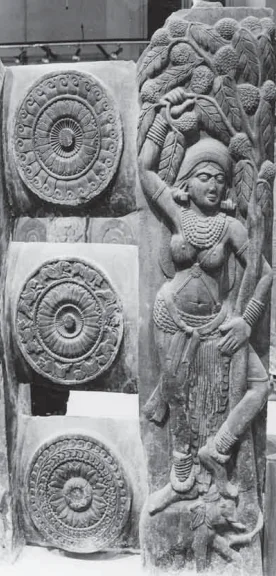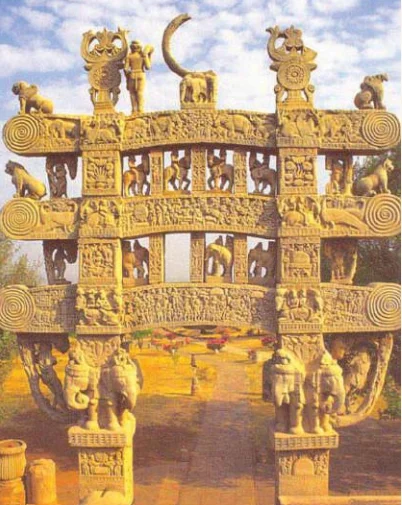Introduction
Post Mauryan sculptures evolved with diverse influences, showcasing Gupta, Kushan, and Gandhara styles. These artworks exhibit advanced techniques and profound cultural expressions, marking a vibrant period in Indian art history.
Prominent Post Mauryan sculptures
Bharhut Sculpture (Madhya Pradesh)
- Green Schist was used for carving the sculptures.
- They are tall, like the images of Yaksha and Yakshi in the Mauryan period.
- Here, the sculptural volume is in low relief, maintaining linearity. Images stick to the picture plane.
- There is a general stiffness in the body and arms.
- Due to the shallow carving of the picture surface, projection of hands and feet was not possible, hence, the folded hands and awkward position of the feet.
- One main characteristic in all the male images of the 1st and 2nd century BC is the knotted headgear.
- Narrative reliefs at Bharhut were used as pictorial language to effectively communicate stories like Queen Mayadevi’s dream, depiction of Ruru Jataka (where the Bodhisattva deer is rescuing a man on his back) etc.

Sanchi Sculptures
- The current stupa at Sanchi was first built during the reign of Ashoka, but it was expanded, and in the first century BC, the outer railing and circumambulatory enclosure were added.
- Stupa-1: Sanchi has an upper as well as lower pradakshinapatha or circumambulatory path.
- It has four beautifully decorated toranas depicting various events from the life of the Buddha and the Jatakas.
- Some of the stories include the Siege of Kushinara, Buddha’s visit to Kapilavastu, and the visit of Ashoka to the Ramagrama Stupa (Nepal).
- Advanced Technique: Carving techniques appear more advanced than Bharhut.
- Heads have a considerable projection in the picture space.
- In the Eastern Gate of the Stupa, there is a scene depicting a bracket figure of a Vrikshika (tree Goddess) or wood nymph in Tribhanga posture.
- Other Examples: Vidisha, Bharhut (Madhya Pradesh), Bodhgaya (Bihar), Jaggayyapeta (Andhra Pradesh), Mathura (Uttar Pradesh), Khandagiri-Udaigiri (Odisha), Bhaja near Pune and Pavani near Nagpur (Maharashtra).

Conclusion
- Post Mauryan sculptures represent a dynamic fusion of regional styles, religious themes, and artistic innovations.
- Post Mauryan sculptures serve as enduring testaments to the rich cultural diversity and creative brilliance of ancient India.
![]() April 13, 2024
April 13, 2024
![]() 1322
1322
![]() 0
0

